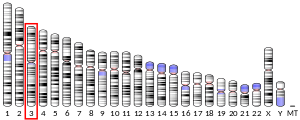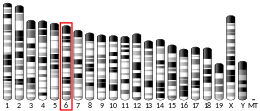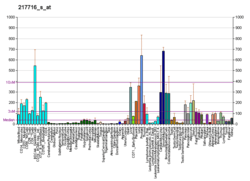Sec61 alpha 1
Protein transport protein Sec61 subunit alpha isoform 1 is a protein that in humans is encoded by the SEC61A1 gene.[5]
The protein encoded by this gene belongs to the SECY/SEC61- alpha family. It appears to play a crucial role in the insertion of secretory and membrane polypeptides into the endoplasmic reticulum. This protein found to be tightly associated with membrane-bound ribosomes, either directly or through adaptor proteins. This gene encodes an alpha subunit of the heteromeric SEC61 complex, which also contains beta and gamma subunits.[5]
References
- GRCh38: Ensembl release 89: ENSG00000058262 - Ensembl, May 2017
- GRCm38: Ensembl release 89: ENSMUSG00000030082 - Ensembl, May 2017
- "Human PubMed Reference:". National Center for Biotechnology Information, U.S. National Library of Medicine.
- "Mouse PubMed Reference:". National Center for Biotechnology Information, U.S. National Library of Medicine.
- "Entrez Gene: SEC61A1 Sec61 alpha 1 subunit (S. cerevisiae)".
Further reading
- Wiertz EJ, Tortorella D, Bogyo M, et al. (1997). "Sec61-mediated transfer of a membrane protein from the endoplasmic reticulum to the proteasome for destruction". Nature. 384 (6608): 432–8. doi:10.1038/384432a0. PMID 8945469.
- Knight BC; High S (1998). "Membrane integration of Sec61alpha: a core component of the endoplasmic reticulum translocation complex". Biochem. J. 331 (1): 161–7. doi:10.1042/bj3310161. PMC 1219334. PMID 9512475.
- Chen Y; Le Cahérec F; Chuck SL (1998). "Calnexin and other factors that alter translocation affect the rapid binding of ubiquitin to apoB in the Sec61 complex". J. Biol. Chem. 273 (19): 11887–94. doi:10.1074/jbc.273.19.11887. PMID 9565615.
- Bebök Z, Mazzochi C, King SA, et al. (1998). "The mechanism underlying cystic fibrosis transmembrane conductance regulator transport from the endoplasmic reticulum to the proteasome includes Sec61beta and a cytosolic, deglycosylated intermediary". J. Biol. Chem. 273 (45): 29873–8. doi:10.1074/jbc.273.45.29873. PMID 9792704.
- Greenfield JJ; High S (1999). "The Sec61 complex is located in both the ER and the ER-Golgi intermediate compartment". J. Cell Sci. 112 (10): 1477–86. PMID 10212142.
- Yamaguchi A, Hori O, Stern DM, et al. (2000). "Stress-associated endoplasmic reticulum protein 1 (SERP1)/Ribosome-associated membrane protein 4 (RAMP4) stabilizes membrane proteins during stress and facilitates subsequent glycosylation". J. Cell Biol. 147 (6): 1195–204. doi:10.1083/jcb.147.6.1195. PMC 2168098. PMID 10601334.
- Petaja-Repo UE, Hogue M, Laperriere A, et al. (2001). "Newly synthesized human delta opioid receptors retained in the endoplasmic reticulum are retrotranslocated to the cytosol, deglycosylated, ubiquitinated, and degraded by the proteasome". J. Biol. Chem. 276 (6): 4416–23. doi:10.1074/jbc.M007151200. PMID 11054417.
- Strausberg RL, Feingold EA, Grouse LH, et al. (2003). "Generation and initial analysis of more than 15,000 full-length human and mouse cDNA sequences". Proc. Natl. Acad. Sci. U.S.A. 99 (26): 16899–903. doi:10.1073/pnas.242603899. PMC 139241. PMID 12477932.
- Ota T, Suzuki Y, Nishikawa T, et al. (2004). "Complete sequencing and characterization of 21,243 full-length human cDNAs". Nat. Genet. 36 (1): 40–5. doi:10.1038/ng1285. PMID 14702039.
- Bouwmeester T, Bauch A, Ruffner H, et al. (2004). "A physical and functional map of the human TNF-alpha/NF-kappa B signal transduction pathway". Nat. Cell Biol. 6 (2): 97–105. doi:10.1038/ncb1086. PMID 14743216.
- Gerhard DS, Wagner L, Feingold EA, et al. (2004). "The status, quality, and expansion of the NIH full-length cDNA project: the Mammalian Gene Collection (MGC)". Genome Res. 14 (10B): 2121–7. doi:10.1101/gr.2596504. PMC 528928. PMID 15489334.
- Otsuki T, Ota T, Nishikawa T, et al. (2007). "Signal sequence and keyword trap in silico for selection of full-length human cDNAs encoding secretion or membrane proteins from oligo-capped cDNA libraries". DNA Res. 12 (2): 117–26. doi:10.1093/dnares/12.2.117. PMID 16303743.
- Ewing RM, Chu P, Elisma F, et al. (2007). "Large-scale mapping of human protein-protein interactions by mass spectrometry". Mol. Syst. Biol. 3 (1): 89. doi:10.1038/msb4100134. PMC 1847948. PMID 17353931.
This article is issued from Wikipedia. The text is licensed under Creative Commons - Attribution - Sharealike. Additional terms may apply for the media files.




